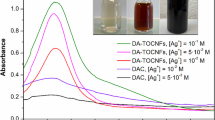Abstract
A polyvinyl alcohol (PVA)-borate hydrogel-based strippable surface decontaminant containing an ammonium salt and Prussian blue (PB) was developed for the removal of 137Cs from various surfaces. This surface decontaminant can be easily prepared by the simple mixing of commercially available materials, such as PVA, borax, NH4Cl and PB, in water, and the decontaminant can be peeled off surfaces due to its high elastic property after surface decontamination. The hydrogel displayed an effective removal performance for Cs from painted cement, aluminum, stainless steel, and cement surfaces and a potential for reusability. Therefore, the PB/PVA-borate hydrogel has good potential as a new surface decontaminant.





Similar content being viewed by others
References
Raio SVS, Lal KB (2004) Surface decontamination studies using polyvinyl acetate based strippable polymer. J Radioanal Nucl Chem 260:35–42
Kinoshita N, Sueki K, Sasa J, Kitagawa J, Ikarashi S, Nishimura T (2011) Assessment of individual radionuclide distributions from the Fukushima Nuclear accident covering central west Japan. Proc Natl Acad Sci USA 108:19526–19529
Calarese E (2011) Improving the scientific foundations for estimating health risks from the Fukushima incident. Proc Natl Acad Sci USA 108(49):10447–10448
International Atomic Energy Agency (2011) Report of the international mission on remediation of large contaminated areas off-site the fukushima dai-ichi NPP
Real J, Persin F, Camarasa-Claret C (2002) Mechanisms of desorption of 134Cs and 85Sr aerosols deposited on urban surfaces. J Environ Radioact 62:1–15
Samuleev PV, Andrews WS, Creber KAM, Azmi P, Velicogna D, Juang W, Volchek K (2013) Decontamination of radionuclides on construction materials. J Radioanal Nucl Chem 296:811–815
Kaminski MD, Lee SD, Magnuson M (2016) Wide-area decontamination in an urban environment after radiological dispersion: a review and perspectives. J Hazard Mater 305:67–86
Technology Evaluation Report from U. S. Environmental Protection Agency (EPA) (2008) Removing radiological contamination from concrete using strippable coating. U.S. Environmental protection agency, Washington, DC EPA/600/S-08/021, October 2008
Yang H-M, Hong SB, Park CW, Lee KW, Choi YS, Yu J-h, Seo B-K, Moon J-K (2016) Magnetic adsorbents embedded in hydrogel bead for surface decontamination. J Nanosci Nanotechnol 16:8569–8574
Yang H-M, Hwang KS, Park CW, Lee K-W (2017) Polyvinyl alcohol-borate hydrogel containing magnetic adsorbent for surface decontamination. Ann Nucl Energy 109:359–364
Yang H-M, Jang S-C, Hong SB, Lee K-W, Roh C, Huh YS, Seo B-K (2016) Prussian blue-functionalized magnetic nanoclusters for the removal of radioactive Cesium from water. J Alloy Compd 657:387–393
Carretti E, Grassi S, Cossalter M, Natali I, Caminati G, Weiss RG, Baglioni P, Dei L (2009) Poly(vinyl alcohol)-borate hydro/cosolvent gels: viscoelastic properties, solubilizing power, and application to art conservation. Langmuir 25(15):8656–8662
Carretti E, Natali I, Matarrese C, Bracco P, Weiss RG, Baglioni P, Salvini A, Dei L (2010) A new family of high viscosity polymeric dispersions for cleaning easel paintings. J Cult Herit 11:373–380
Natali I, Carretti E, Angelova L, Baglioni P, Weiss RG, Dei L (2011) Structural and mechanical properties of peelable organoaqueous dispersions with partially hydrolyzed poly(vinyl acetate)-borate networks: applications to cleaning painted surfaces. Langmuir 27:13226–13235
Chen CY, Yu T-L (1997) Dynamic light scattering of poly(vinyl alcohol)-borax aqueous solution near overlap concentration. Polymer 38:2019–2025
Fuchs T, Richtering W, Burchard W, Kajiwar K, Kitamura S (1998) Gel point in physical gels: rheology and light scattering from thermoreversibly gelling schizophyllan. Polym Gel Netw 5(6):541–559
Singh NS (2013) Effect of surfactants on polyvinyl alcohol-borax hydrogel: rheology and thermal aspects. Indian J Chem 52A:879–883
Keita G, Ricard A, Audebertt R, Pezron E, Leibler L (1995) The poly(vinyl alcohol)-borate system:influence of polyelectrolyte effects on phase diagrams. Polymer 36:49–54
Haas PA (1993) A review of information on ferrocyanide solid for removal of cesium from solutions. Sep Sci Technol 28:2479–2506
Thammawong C, Opaprakasit P, Tangboriboonrat P, Sreearunothai P (2013) Prussian blue-coated magnetic nanoparticles for removal of cesium from contaminated environment. J Nanopart Res 15:1689–1699
Fujita H, Sasano H, Miyajima R, Sakoda A (2014) Adsorption equilibrium and kinetics of cesium onto insoluble Prussian blue synthesized by an immediate precipitation reaction between Fe3+ and [Fe(CN)6]4−. Adsorption 20:905–915
Buser HJ, Schwarzenbach D, Petter W, Ludi A (1977) The crystal structure of Prussian blue: Fe4[Fe(CN)6]3·xH2O. Inorg Chem 16(11):2704–2710
Technology Evaluation report from U. S. Environmental Protection Agency (EPA) (2011) CBI polymers Decongel 1101 and 1108 for radiological decontamination. U.S. Environmental Protection Agency, Washington, DC EPA/600/R-11/084 August 2011
Gray HN, Jorgensen B, McClaugherty DL, Kippenberger A (2001) Smart polymeric coatings for surface decontamination. Ind Eng Chem Res 40:3540–3546
Koike A, Nemoto N, Inoue T, Osaki K (1995) Dynamic light scattering and dynamic viscoelasticity of poly(viny1 alcohol) in aqueous borax solutions. 1. Concentration effect. Macromolecules 28:2339–2344
Acknowledgements
This work was supported by a National Research Foundation of Korea grant funded by the Korean government (MSIP) (No. 2017 M2A8A5015148).
Author information
Authors and Affiliations
Corresponding author
Rights and permissions
About this article
Cite this article
Yang, HM., Park, C.W., Lee, K.W. et al. Polyvinyl alcohol-borate hydrogel containing Prussian blue for surface decontamination. J Radioanal Nucl Chem 316, 955–962 (2018). https://doi.org/10.1007/s10967-018-5745-0
Received:
Published:
Issue Date:
DOI: https://doi.org/10.1007/s10967-018-5745-0




